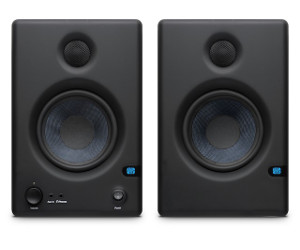PreSonus Ships Compact Eris E4.5 Studio Monitors
The Eris series of two-way monitors from PreSonus continues to expand – and shrink at the same time.
The latest model to arrive is the ultra-compact Eris E4.5 studio reference monitor. PreSonus’ Eris line – which also includes the E5 and E8 — can be user-adjusted to the acoustic space, allowing users to create a more accurate listening environment or to simulate different common listening environments. – a feature not typically provided by studio monitors in this price point.

The Eris E4.5’s controls allow users to create a linear response for accurate monitoring, customized to their space.
Available now for a street price of $199.95/pair, PreSonus sees the E4.5 as ideal for “bedroom studios, school music programs, and as a high-quality replacement for computer speakers.”
Here are more details on these diminutive monitors, straight from PreSonus:
The Eris E4.5 features a 4.5-inch, Kevlar low-frequency transducer, a 1-inch (25 mm), silk-dome, high-frequency tweeter, and a rear bass-reflect port. Each speaker is powered by a 25W Class AB amplifier-plenty of juice for a small speaker. Peak SPL is rated at 100 dB. The E4.5 ranges from 70 Hz up to 20 kHz, and at 6.42 x 9.45 x 7.09 inches (163 x 241 x 180 mm), you can shoehorn it into almost any studio space.
The Eris E4.5 has balanced ¼” TRS and unbalanced RCA inputs, as well as unbalanced 1/8″ inputs for a smartphone or MP3 player, giving you the flexibility you need when replacing computer speakers or older studio monitors.
A four-position Acoustic Space switch controls a second-order shelving filter, centered at 1 kHz, that provides three attenuation points (no attenuation, -2 dB, and -4 dB), allowing you to control the bass response relative to the wall proximity of your speakers. A High Pass switch sets the low-frequency cutoff (second-order slope, -12 dB/octave) to be flat, 80 Hz, or 100 Hz. You also get continuously adjustable (±6 dB) High Frequency and Midrange controls.
This combination of controls lets you create a linear response for accurate monitoring. It also enables you to simulate different listening environments, so you don’t have to listen to mixes on your car, consumer computer speakers, and home stereo to check how the music sounds with different systems. Instead, you can adjust the Eris monitors’ response and test your mixes without leaving your studio.
|
|
Please note: When you buy products through links on this page, we may earn an affiliate commission.







